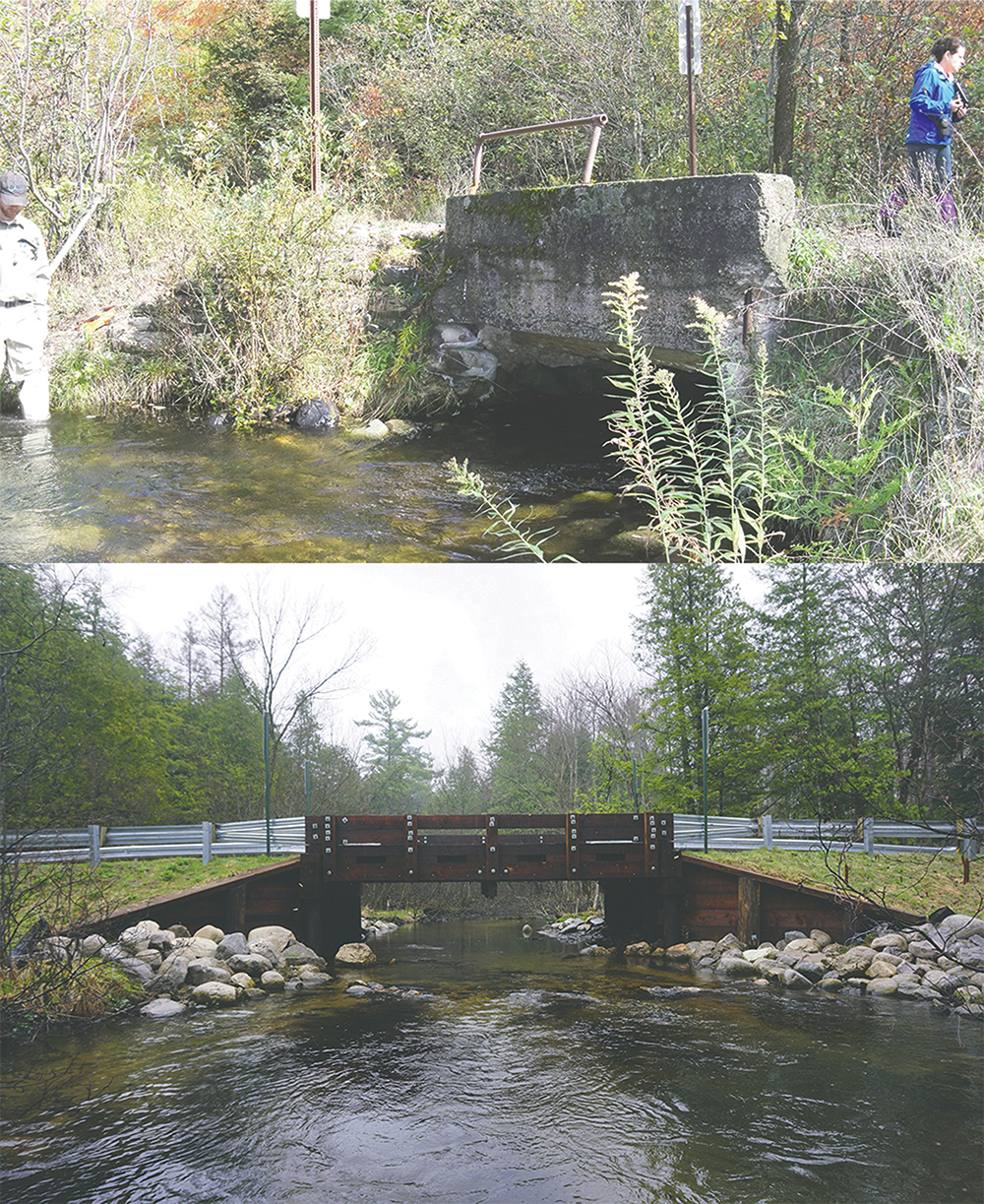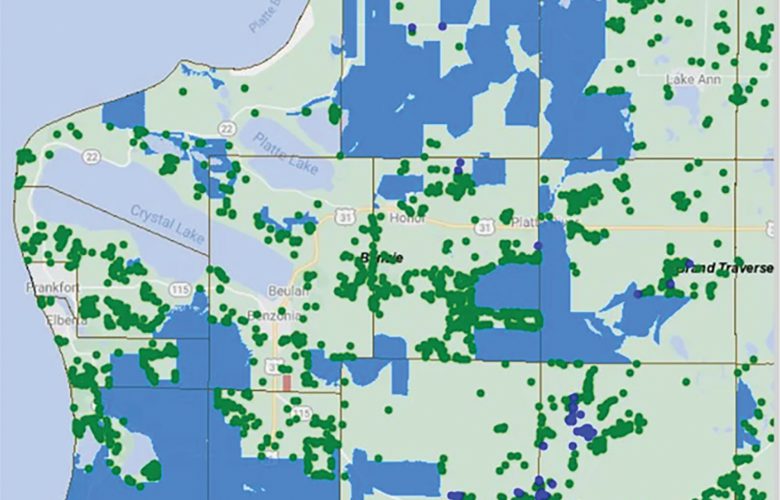Coming together for the future
By Annis Pratt
Current Contributor
I do not know about you, but when I see the first purple leaves of skunk cabbage poking through the marsh, I know that spring has come—everything is regenerating itself after the long, long months of snow and sleet and freezing temperatures of an especially hard winter. It is a yearly miracle, but a miracle nonetheless, reminding us of nature’s fiercely self-redemptive powers of regeneration.
Our Northern Michigan world is a world of rivers teeming with salmon and steelhead, brook trout and brown trout, and a rich multitude of wetland creatures. We live in such an abundant watershed system, because we have refrained from degenerating its abundance by overbuilding and riverbank erosion.
Our state’s Natural Rivers Act of 1973 much disputed at the time as government interference—has enhanced the ecosystem of 16 local rivers: the Au Sable, Betsie, Boardman, Flat, Fox, Huron, Jordan, Lower Kalamazoo, Pere Marquette, Pigeon, Pine, Rifle, Rogue, Two Hearted, Upper Manistee, and White.
This effort protects the natural quality of these select river systems throughout the state by regulating their use and development through zoning rules—while, by the way, enhancing property values all along them. The Natural Rivers Program was developed to preserve, protect and enhance our state’s finest river systems for the use and enjoyment of current and future generations by allowing property owners their right to reasonable development while still protecting Michigan’s unique river resources. The designation includes the mainstream, as well as most of the tributaries. Nearly all construction, land change/earth moving, and placement of structures is regulated within 400 feet of any designated stream segment.
When I first came to our Betsie River cabin—which we purchased in 1992 because of the Natural Rivers Act—we invited a Michigan Department of Natural Resources (DNR) agent to explain how we could keep our property in compliance.
He asked us to remove patio pavers on the lawn leading to the river, and he suggested that we refrain from mowing the grass. He planted two little pine trees, so that their roots could help to stabilize the bank; he asked us to keep anyone from climbing up them, so that smaller shrubs could take hold.
As a result, my overgrown banks provide shade for steelhead to linger and feed—I see them there every summer, on their way from Lake Michigan to spawn in one of the many clear-running Betsie tributaries. Fisherfolk cast into the stretch of river along our property, so I protect the banks from their scramblings by offering parking and access, if they agree to use our river stairs instead.
As a result, my meadow is lush with daisies, pearly everlastings, Queen Anne’s lace, black-eyed Susans, and asters in seasonal succession, while my river banks are overgrown with a lush profusion of willow shrub, dogwood, wild grapes, cardinal flower, St. John’s wort, Veronica, and any number of unidentifiable, lovely flowers whose seeds have washed ashore to flourish.
Nature regenerates when—with our projects of protection and restoration—we humans refrain from degeneration.
Soon after we arrived, we joined the Betsie River Restoration Committee, which is now partnered with the Conservation Resource Alliance (CRA). This Traverse City-based nonprofit collaborates with numerous local organizations to protect 700 miles of rivers, 5,000 miles of tributaries, and 4 million acres of forest in Northern Michigan.
One of CRA’s recent projects involves anchoring whole trees along Platte River to create a shadier fish habitat—undertaken in partnership with the Tribal Stream and Fruit Belt Partnership—and replacing nine undersized stream crossings in cooperation with the Benzie County Road Commission. (Editor’s Note: In 2016, The Betsie Current published “A Bridge Story: Protecting bridges and saving fish on the Betsie,” which chronicled a similar project along the Betsie River; find it in our online archives.)
This is just one example of the diverse partners, stakeholders, and donors working with CRA to enable ecosystem restoration, especially the DTE Foundation and including Consumers Energy, Trout Unlimited, the Little River Band of Ottawa Indians, the Grand Traverse Band of Ottawa and Chippewa Indians, Fish America Foundation, Orvis, Manistee County Sport Fishing Association, U.S. Fish and Wildlife Service, Patagonia, the Michigan DNR, the Michigan Department of Environment, Great Lakes, and Energy (EGLE), and the Benzie and Grand Traverse county road commissions.
I list all of these because—in a time when we are deeply worried about climate change—it is heartening to realize that so many people from so many different kinds of organizations and points of view are able to work together on behalf of the watersheds and wetlands, the lakes and rivers that we cherish here in Northern Michigan.
The overall philosophy behind these activities represents a radical shift from the 1970s in that now we understand our place in nature.
We humans used to assume that nature is “other” than us and there for us to exploit. With the exception of Native Americans—whose theologies understand humans as fellow beings with others to whom they accord respect and consideration—we tend to forget that we are a part of nature, elements in an interdependent web of existence that we throw out of balance at our peril.
When we join with like-minded organizations in river or wetland restoration, we recognize that, when an ecosystem degenerates, human communities degenerate with it—and that we must refrain from constructing barriers for its natural regeneration.
Or, as the great naturalist Aldo Leopold put it: “We abuse land because we regard it as a community belonging to us. When we see land as a community to which we belong, we may begin to use it with love and respect.”
Annis Pratt has a cottage on the Betsie River. She has been a bird watcher since 1947 and finds the banks of the Betsie an absolute bird paradise. She is author of The Infinite Games Series of adventure novels about a marshland folk who are threatened by the draining of their homeland and of three non-fiction books about the way that myths are used in literature. She is a nature writer, a columnist for the international e-magazine Impakter.com, and was an early contributor to The Betsie Current, back in the 2005-06 days. Visit AnnisPratt.com to learn more or look for her books on Amazon.
Featured Photo Caption: Where Hooker Road crosses the north branch of the Platte River, an undersized four-inch diameter boiler plate pipe was set above the stream bottom, causing pools to form at the inlet and outlet. Now, a timber bridge wide enough for two vehicle lanes allows the stream to run smoothly. Since 2019, Conservation Resource Alliance (CRA), Benzie County Road Commission, and other partners have restored nine crossings like this one within the Platte River Watershed. Many of these aging structures—outdated metal culverts and cracking concrete structures—obstructed streambeds and created waterfalls too strong for the upstream passage of young fish and sensitive species like brook trout and sculpin. In addition, near-vertical roadbed embankments funneled excess stream sedimentation during rain and snowmelt, dumping an estimated 25 tons of sediment each year that destroyed fish and aquatic insect habitat. Photo courtesy of Conservation Resource Alliance.
SIDEBAR:
Protecting Bridges and Saving Fish
Avid Benzie County fisherfolk may not know it, but the work of the Traverse City-based Conservation Resource Alliance (CRA) is integral to protecting cold-water-loving species such as steelhead, trout, and salmon in our streams.
The CRA was established in 1968 to preserve and protect Northern Michigan’s waterways, wildlife, and forests. The alliance protects watersheds in 13 counties, from Beaver Island to the Pere Marquette and Manistee rivers.
Here in Benzie, CRA focuses on the Betsie and Platte rivers, both important spawning grounds in the spring and the fall.
The Conservation Resource Alliance—together with partners that include the Benzie County Road Commission and some grant-giving organizations—previously built timber bridges across three points on the Upper Betsie, one of the coldest tributaries to the Betsie River.
In July 2016, they replaced another road crossing on Red Creek, a tributary to the Betsie, near Thompsonville. Reinforcing these aging and ailing bridges opened up the river channel and let the stream—and the fish—flow more naturally beneath them.
One other place that has been redone is at the intersection of Nessen and Bentley roads, rustic two-tracks to the northeast of Thompsonville where the Upper Betsie makes a bucolic meander through rural Benzie County before feeding the main Betsie River, which eventually dumps into Frankfort and Elberta’s Betsie Bay and Lake Michigan.
This stretch suffers from warm water temperatures during the high summer months, according to Kim Balky, a project manager and biologist with the CRA. Yet fishermen rely on the health of these tributaries, because the Little Betsie and Deer Creek are cold-water havens for trout and great nurseries for steelhead and salmon.
But now, the Nessen-Bently intersection flows freely, thanks to the CRA stepping in.
Since 2019, CRA, Benzie County Road Commission, and other partners have collectively restored nine crossings within the Platte River Watershed, including sites on the North Branch, as well as Kinney, Brundage, Little Platte Lake and Carter creeks.
More than 10 miles of upstream reaches are now fully reconnected with 19 miles of downstream tributaries and the Platte River mainstem, along with Little and Big Platte lakes.
Full passage for all aquatic species at all life stages during ordinary and high-water flows is now a reality.




